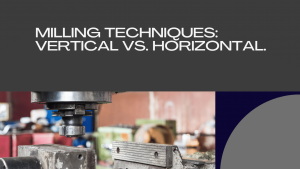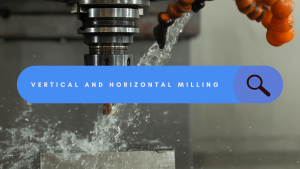The milling process is a machining process that generally happens when rotary cutters are used to remove material from a workpiece. It is a vague technique that is used to make different forms and sizes. When it comes to milling, there are two main methods: machining processes, such as vertical milling, and horizontal milling. Selecting the most appropriate method for your project here is a matter of utmost importance since it can ultimately affect how the overall output will look and the operation itself.
Understanding the Differences between Vertical and Horizontal Milling
Vertical milling is the name for the milling machine, which has the spindle on the vertical axis. It is the case that the tool is located vertically above the workpiece in this process. By contrast, horizontal milling is defined as the milling machine that carries the spindle axis horizontally placed. For this application, the cutting tool is held horizontally, spanning the workpiece.

When it comes to the difference between vertical and horizontal milling, there are a number of factors that need to be taken into account. The orientation of the spindle axis determines the direction of the tool approaching the workpiece in the first instance. In vertical milling, the tool travels downwards into the workpiece; on the other hand, in horizontal milling, the tool slides sideways across the workpiece. First of all, vertical milling machines usually specialize in handling small, more complicated tasks, whereas horizontal milling machines are more useful for large, stubborn tasks.
Advantages and Disadvantages of Vertical Milling
There are many advantages to vertical milling. Firstly, it allows for quick and easy access to the workpiece, which is suitable for accurate cuts, for example of artistic projects. Besides that, most of the vertical milling machines are furthermore provided with digital readouts and power feeds, which provide a higher degree of accuracy and efficiency. They also come in handy in saving space and are quite affordable compared to horizontal milling machines.
Additionally, the vertical milling is not flawless as well. A key disadvantage is that it may take a long to cut the bulk of the material since the lower force the cutting tool exerts. In addition, the vertical milling machines do not well fit to heavy-duty tasks which need a high torque and power. However, one disadvantage of this machine is the vertical orientation of the spindle axis which can make it difficult to mill large workpieces.
Advantages and Disadvantages of Horizontal Milling
However, horizontal milling has it own benefits as well. Therefore, it aids the removal of excessive amounts of material in a rapid and precise manner. This is an advantage to heavy-duty applications that require high torque and strong power. Besides, horizontal milling machines are likely to feature automatic tool changers, which ensure smooth and quick changing of tools. In addition, horizontal milling machines can perform tasks on larger workpieces, as they are oriented horizontally.
There are some drawbacks to this particular process. One of the biggest problems is that it is harder to make accurate incisions and fine designs, which vertical milling is better at. The other thing is that horizontal milling machines are more bulky, expensive and take up larger amounts of space compared to vertical milling machines. Finally, the shape of the spindle axis, along with the horizontal one, is a reason for the difficulties in the arrangement of the workplace for installation and service.
Factors to Consider When Choosing Between Vertical and Horizontal Milling
When pondering between vertical and horizontal milling, several variables need to be taken into account. First of all, the nature of the material milled is an important factor to consider. Some materials can be used on a vertical milling machine, while others may need horizontal milling features. Also, the project size and its complexity should be realized. Smaller, intricate projects can be better served using vertical milling machines, whereas larger, generally heavy-duty ones may be more appropriately fulfilled by horizontal milling machines.
Moreover, the issues of price and availability of the equipment should also be taken into account. Vertical milling machines (VMs) are often cheaper and simpler to obtain compared to horizontal milling machines (HMs). On the other hand, if your task requires the functions of a horizontal milling device, it is probable that you will compensate for the higher price despite the fact. In addition to this, the operator’s skill level has to be taken into account. With regard to vertical milling machines, tend to be more operator-friendly and ask for less skills. On the other hand, horizontal milling machines demand more experience and expertise.
Applications of Vertical and Horizontal Milling
Vertical milling is one of the most common operations that are widely used in the aerospatial, automobile, and electronic manufacturing industries. It has performed very well in projects with designs that are very complex and cuts that are very accurate. The applications in the industry are realizable through the creation of molds, dies, and small parts.

Compared to vertical milling, which has found its application mainly in the medical field, horizontal milling is more commonly used in construction, manufacturing, and heavy machinery industries. It is better for demolition works that need to be done quickly and that produce a lot of debris. As applications manifest in the production of gears, shafts, and other large components is one of the examples.
Which Milling Method Is Best for You?
Lastly, picking the proper milling method for your work is vitally important. Vertical and horizontal milling enjoy their own merits and demerits, and each of them has its own values. Aspects of milling such as the material type, project size and complexity, price of the equipment, and the skill level of the operator should be given due consideration.
If you are going to work on a complicated project and need more accurate cuts, vertical milling can be said to be the perfect option for you. On the one hand, if you have to cut a big amount of material in a short time with a high efficiency, then horizontal milling may be more appropriate. In the end, the choice should be determined by your particular project or sector that requires the specific needs.
